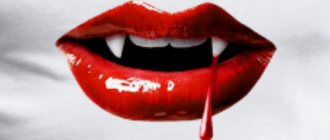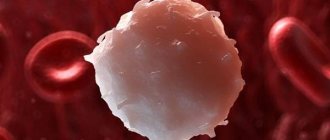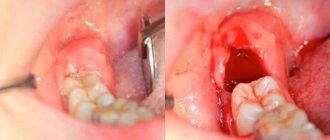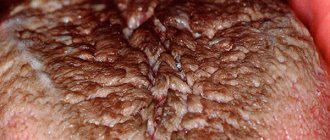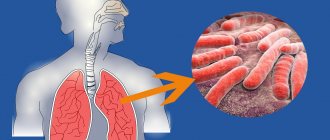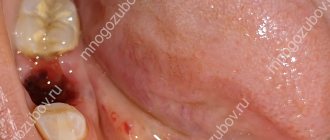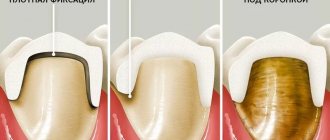What to do if the bleeding does not stop?
Flowing from the wound, the blood quickly begins to clot.
The resulting clot closes the wound and the bleeding stops. But sometimes this doesn't happen. The cause may be the development of the disease. If the bleeding does not stop for a long time, this is a reason to consult a doctor. What is the reason for this phenomenon and how to solve the problem correctly? Most often, bleeding disorders are hereditary. But if everything was fine before this, then you should be wary. This problem may be a symptom of one of the following diseases:
- lack of vitamin K in the body;
- liver damage, including cancer;
- a sharp decrease in the level of platelets in the blood;
- anemia – lack of hemoglobin.
In rare cases, bleeding disorders can be caused by long-term use of antibiotics or drugs designed to prevent blood clots.
If you notice a similar symptom, be sure to seek help from a doctor. You will need to undergo a medical examination.
In order to avoid infection of the wound, it must be properly treated. This is the only way you can stop the bleeding without negative health consequences. Follow the following sequence of actions.
- First of all, the wound must be washed in clean cool water and treated with an antiseptic. Hydrogen peroxide or brilliant green are best for this. Soak a cotton swab in the liquid and apply to the wound. If the cut is deep enough, pour antiseptic directly into the wound.
- There is no need to try to stop the bleeding immediately. Along with it, bacteria are removed from the wound, which can cause inflammatory processes. Ideally, it should fold on its own. If the bleeding does not stop, it is necessary to treat the wound again with an antiseptic and cover it with a bandage or seal it with a plaster.
- If the blood continues to flow very quickly, keep the wound in a solution of potassium permanganate for some time.
- If a limb is injured, you can apply a tourniquet to it. It should be fixed at a height of 5 cm from the wound. Remember that you cannot leave the tourniquet on your body for more than an hour. It should be loosened from time to time.
- If none of the above measures help stop the bleeding, you should immediately contact the emergency room.
Large blood loss is very dangerous to your health, so if you have suffered a serious injury, it is better to seek help from a doctor as soon as possible.
The washing machine does not stop - causes of malfunction
According to statistics, few users know how long washing actually takes. Automatic devices, once started, do not require owners to monitor them. At the end of the process they turn off. It happens that the washing machine fills with water and does not stop . The following factors will help determine the reason for prolonged washing:
- scale has formed on the heating elements;
- connection to the sewer system;
- correct operation of the sensors from which the signals come.
Without stopping, the equipment can function when an electronic failure occurs. It is almost impossible to predict the consequences in this case. To the question: “ What to do if the washing machine does not stop?” Only a professional who can deal with similar situations every day can answer. The owner of the device must listen to the recommendations of a specialist.
Poor blood clotting: causes, symptoms, treatment
A problem in which the blood does not clot well is called a bleeding disorder. It is caused by the fact that blood vessels do not normally become blocked when they are damaged.
When everything is fine, when there is bleeding at the wound site, the blood begins to thicken, which prevents large losses. But sometimes this complex mechanism fails, resulting in severe or prolonged bleeding.
When blood does not clot well, this does not always lead to external loss. It can also appear as bleeding under the skin or in the brain.
Causes of poor blood clotting
Blood does not clot well when there are problems with blood clotting factors - the substances in the blood that enable this process. Most of these substances are different proteins. Therefore, many causes are associated specifically with protein defects in plasma (the liquid component of blood). These proteins are directly responsible for how blood clots, responsible for blocking damaged blood vessels. In some diseases, they may be completely absent or present in too low quantities. Most of these diseases are hereditary (passed from parent to child through genes).
However, poor blood clotting can be caused by more than just genetic abnormalities. Here is a list of all the main reasons:
- Hereditary disorders. These primarily include hemophilia and von Willebrand disease. Hemophilia is a disease accompanied by poor blood clotting. Von Willebrand disease is a disorder in which the blood factor of the same name (von Willebrand) is insufficient or completely absent, which leads to coagulation disorders;
- Vitamin K deficiency;
- Carcinoma of the liver itself or damage to its cells by cancer from other organs;
- Other liver damage and diseases, most often infectious (hepatitis) and causing scarring (cirrhosis);
- Long-term use of powerful antibiotics or anticoagulant drugs (drugs that are aimed at combating the formation of blood clots);
- The use of drugs called angiogenesis inhibitors, which in some cases are needed to slow and prevent the growth and development of new blood vessels in the body;
- Thrombocytopenia is a condition in which the level of platelets falls below the established norm;
- Anemia is a condition when the level of hemoglobin or red blood cells falls below the established norm;
- Some other disorders not caused by cancer.
Read also: How to remove a tooth root
The most common causes of blood clotting problems are:
Based on the above, the causes of poor blood clotting can be divided into inherited (passed on by genetics) and acquired. Some of them cause bleeding spontaneously, while others cause blood loss after vascular damage - trauma.
- The most common hereditary bleeding disorders are: hemophilia A and B, caused by a deficiency or absence of certain proteins that perform the function of blood clotting, which are included in the group of factors. This disorder causes heavy or unusual bleeding.
- Deficiencies of coagulation factors II, V, VII, X, XII – cause blood clotting problems or abnormal bleeding.
- Von Willebrand disease is the most common inherited bleeding disorder caused by a deficiency of von Willebrand factor (one of the plasma proteins), which helps platelets clump and stick to the wall of a blood vessel.
Some diseases and medical conditions can also cause a deficiency of one or more clotting factors. The most common causes of acquired bleeding disorders are end-stage liver disease or vitamin K deficiency. According to the American Association of Clinical Chemistry (AACC), this is because most clotting factors are produced in the liver and some clotting factors are vitamin K dependent.
Symptoms of poor blood clotting
The main sign of a bleeding disorder is bleeding that lasts a long time or is too heavy. The bleeding is usually heavier than usual and for no obvious reason. Other symptoms include:
- unexplained bruises;
- heavy menstrual bleeding;
- frequent nosebleeds;
- stopping bleeding from minor wounds for too long.
Blood flows from the socket of an extracted tooth for a long time: causes and types of bleeding
Bleeding from the socket of an extracted tooth has a different character:
- parenchymal blood leaks from the entire surface of venous wounds;
- dark red blood flows out evenly;
- arterial bright red blood flows in a strong pulsating stream.
Based on the time (period) of occurrence of bleeding, they are divided into 2 types:
- early - opening immediately after the tooth is pulled out, or occurring within 24 hours;
- later - starting the next day or a few days later (for hemophilia on days 5 and 6).
Small hemorrhages, which begin after about 2–4 hours, often open due to the administration of large doses of anesthetic drugs: adrenaline in their composition provokes a temporary constriction of blood vessels. The narrowed vessels continue to contract, which can lead to hemorrhage and the release of ichor.
The reasons why bleeding does not stop after tooth extraction are local:
- rough and violent manipulation of sharp instruments;
- injury or damage to soft tissues in the oral cavity;
- bone crushing or fragmentary fracture of the alveolar bone;
- anatomical abnormalities in the structure of blood vessels;
- mechanical injury to the formed clot (during eating).
Often, blood flows after the completion of a tooth extraction procedure in women during menstruation, which may be associated with a disorder of hemostasis or hemorrhagic diathesis (increased tendency of the body to bleed). Other factors that negatively affect the vascular wall and contribute to prolonged bleeding are:
- atherosclerosis;
- exposure to chemical toxic agents;
- infectious, viral and bacterial diseases;
- neoplasms;
- leukopenia;
- allergy;
- deficiency of vitamins PP and C;
- decreased platelet count – thrombocytopenia;
- blood pathologies (anemia);
- liver diseases;
- hypertonic disease;
- rheumatic diseases;
- diabetes.
What to do if blood doesn't clot well
If you have the symptoms listed above, you should definitely consult a doctor and undergo an examination. At the moment of bleeding itself, first aid should be provided in accordance with general recommendations, based on the location and type of injury. If necessary, call an ambulance.
Diagnostics
To diagnose blood clotting, the doctor first reviews the patient's medical history. To do this, he will ask questions about your health problems and medications you are taking. You need to answer something like this list of questions:
- What are the accompanying symptoms?
- How often does bleeding occur?
- How long does the bleeding last?
- What were you doing before the bleeding started (for example, were you sick, took medications)?
Basic tests to check blood clotting :
- A complete blood count to check the blood loss at the time the test was taken and the number of red and white blood cells.
- Platelet aggregation test, which shows the extent to which platelets are able to adhere to each other.
- Measuring bleeding time to see how quickly blood vessels clog after pricking a finger with a feather.
Treatment options for poor blood clotting
Treatment for a bleeding disorder is based on the causes that cause it. If possible, the diseases that caused the disorder, such as cancer or liver disease, are immediately treated. Additional treatments include:
- Taking vitamin K by injection;
- Drugs aimed at improving clotting function;
- Transfusion of frozen donor blood plasma or donor platelets;
- Other drugs, including hydroxyurea (Droxia, Hydrea), and oprelvequin (Neumega) to treat platelet-related disorders.
Treatment of consequences caused by blood loss
Iron supplements
If there is significant blood loss, the doctor may prescribe medications containing iron to replenish its amount in the body. Low iron levels can lead to iron deficiency anemia, which is accompanied by feelings of weakness, shortness of breath and dizziness. One of the most common and accessible drugs in this case is Hematogen. In addition to treatment with iron supplements, blood transfusions may be required.
Blood transfusion
During this procedure, as most people know, blood loss is compensated with the help of donor blood. Donated blood must match your blood type to prevent complications. This procedure can only be performed in a hospital.
Complications of bleeding disorders
The best treatment results can be achieved if treatment is started as early as possible. Complications can occur if it is started too late or after heavy bleeding.
Common complications of bleeding disorders:
- bleeding in the brain;
- bleeding in the gastrointestinal tract;
- bleeding and joint pain.
Stop bleeding
The best option for what to do if the bleeding does not stop after tooth extraction is to contact a specialized institution. This rule should be taken as the main one and if there is such an opportunity, then it should not be neglected under any circumstances. Qualified specialists will provide assistance much faster and better than what an ordinary person can achieve at home. Moreover, if there is severe bleeding, the cause of which is the use of anticoagulants, then it is simply necessary to go to the clinic, since independent actions will be ineffective.
If the decision is made in favor of a “home” solution to the problem, then here you can mention:
- Vasoconstriction
– before surgery to remove a tooth, doctors often inject a drug into the gums that locally narrows the blood vessels. This can significantly reduce blood loss. At home, a similar result can be achieved by applying ice or other frozen product to your cheek.
- Mechanical impact
- here we are talking about closing the wound in the usual way, which will lead to the appearance of a blood clot that will prevent bleeding. For these purposes, you can use an improvised gauze swab or a special hemostatic (hemostatic) sponge. The tampon must be placed directly into the hole left after tooth extraction and pressed firmly with the jaw.
- Special preparations
– Taking medications that lower blood pressure can be used as one of the measures to stop bleeding. Naturally, before using them, you need to make sure that the indicators are overestimated. As a rule, hypertensive patients always have a tonometer at hand and are aware of their problem. But blood pressure can also rise due to stress.
The listed methods of stopping bleeding after tooth extraction are the main ones and if they are ineffective, you need to contact a specialized clinic, and sometimes you need to go to an ambulance.
In any case, prevention of the problem should be in the first place, and therefore, a few days before the proposed operation, you should refrain from taking blood thinning medications, and after the operation, strictly follow the doctor’s recommendations. This article is for informational purposes only, please consult your doctor for details!
Low blood clotting
Under normal conditions, blood is constantly in a liquid state. If a vessel is damaged, tissue particles enter the bloodstream and the blood clotting process begins. In this case, a blood clot forms, which clogs the damaged area.
Read also: Is it possible to wash a wound with chlorhexidine?
Poor blood clotting may occur under certain circumstances. This is fraught with severe bleeding and health problems. Therefore, it is important to promptly find out the reasons for this phenomenon and take action.
First aid
The success of treating cuts largely depends on timely first aid provided to the victim.
Cleaning the wound
First of all, it is necessary to clean the wound surface. It may contain:
- dirt;
- glass particles;
- rust and other elements depending on how the leather was damaged.
If help was not provided immediately, for example, the person was unconscious, was not found immediately, there were no available means, stagnant and dried blood may accumulate in the wound.
The best treatment for minor cuts and scrapes is to wash with clean water and soap using a cotton or gauze pad.
All this must be thoroughly cleaned using a swab soaked in hydrogen peroxide. If the incisions are heavily soiled, wash with cooled boiled water or running water and soap (it is better to use laundry detergent or with an antibacterial effect). After using soap, you need to make sure that the foam is rinsed off well to avoid chemical burns.
Please note that cotton wool for washing and processing can be used after wrapping it with gauze. Cotton fibers caught in the wound are difficult to remove.
Treatment
After washing the wound:
- Dry the damaged area with a napkin or clean cloth.
- The edges of the wound are treated with an antiseptic (for example, 5% iodine solution, brilliant green).
- The cut is covered with a sterile cloth and, if necessary, secured with a bandage.
- If blood leaks out, another bandage is applied on top - a pressure bandage (tighter).
Before applying a bandage, make sure that the wound is clean and free of foreign bodies.
If limbs are damaged, it is important to monitor their condition. If your legs and arms swell and turn blue, the bandage may be too tight and needs to be loosened.
When treating cuts, they use products to stop bleeding, relieve pain, heal wounds, relieve swelling and other painful symptoms.
What is this disease
Blood consists of many components: proteins, platelets, red blood cells, fibrins and others. It is responsible for the delivery of nutrients and oxygen to all internal organs and tissues.
In order to prevent serious blood loss due to vascular damage, a process is provided for the formation of blood clots when tissue factor enters the bloodstream. If this process is disrupted, this indicates the presence of a disease.
Poor blood clotting is associated with a lack of certain enzymes. There is a decreased production of platelets. This pathology is dangerous to human health and life. If the damage to the blood vessels is severe, severe blood loss can lead to death .
Depending on the provoking factor, there may be several answers to the question of what the disease is called:
- If the pathology is associated with a lack of fibrinogen in the blood, then the coagulation disorder is called fibrinopenia.
- When a hereditary factor plays a key role, the disease is usually called hemophilia. Mostly men suffer from this problem.
- The disease caused by a lack of platelets is called thrombocytopenia.
These diseases have similar causes and are characterized by the same symptoms.
Plan for morphological analysis of a noun
Baby (answers the question who?) – noun;
- initial form - baby;
- constant morphological features: animate, common noun, concrete, masculine, 1st declension;
- inconsistent morphological features: nominative case, singular;
- when parsing a sentence, it plays the role of subject.
Morphological analysis of the word “milk” (answers the question of whom? What?).
- initial form – milk;
- constant morphological characteristics of the word: neuter, inanimate, real, common noun, II declension;
- variable morphological features: accusative case, singular;
- direct object in the sentence.
Here is another example of how to make a morphological analysis of a noun, based on a literary source:
What is the cause of the disease?
The causes of poor blood clotting can be varied. Moreover, in men and women, the disease can be caused by various factors. Nevertheless, there are a number of general prerequisites:
- Liver diseases.
- Malfunctions of the immune system.
- Long-term treatment with non-steroidal anti-inflammatory drugs.
- Acute lack of calcium in the body.
- Allergic reactions, which are accompanied by a significant release of histamines into the blood.
- Development of cancer.
- Therapy with drugs aimed at treating cardiovascular diseases.
- Unfavorable environmental conditions, employment in hazardous industries.
- Lack of vitamin K in the body.
- Long-term treatment with potent antibacterial drugs.
- Taking medications designed to prevent the formation of new blood vessels in the body.
In women, treatment of varicose veins often causes problems. It is carried out using specialized drugs, for example, Troxevasin, Warfarin, Detralex and others. These drugs can greatly thin the blood, which leads to the formation of disorders.
In men, a common cause of the problem is a hereditary factor. A disease such as hemophilia is often passed down from generation to generation through the male line.
Causes of disease in children
Bleeding disorders can occur even at an early age. The most common causes in children are:
- Diseases of the cardiovascular system.
- Congenital hemophilia, which is inherited by the child.
- Lack of vitamin K in the body.
- Autoimmune diseases.
- Performed blood transfusion.
Poor blood clotting in a child can be extremely dangerous for his health and even life. Therefore, it is necessary to diagnose it as early as possible and begin treatment.
Causes and dangers of bleeding disorders during pregnancy
While carrying a baby, a woman’s body undergoes enormous changes, so it is forced to adapt to new circumstances. Changes are happening in many systems. This often leads to disruptions, including in the circulatory system. Among the main causes of poor blood clotting during pregnancy are:
- Premature placental abruption.
- Amniotic fluid embolism.
- Restructuring of the immune system caused by pregnancy.
Blood clotting disorders in pregnant women can lead to negative consequences for health and even life . There is a high risk of postpartum hemorrhage, premature birth or miscarriage. Therefore, specialists must prescribe a number of appropriate tests to identify pathology.
A pregnant woman needs to be careful about her health. A complete cessation of smoking and drinking even small doses of alcoholic beverages is mandatory. You should properly build a drinking regime, since excess fluid in the body can cause blood thinning.
How to spell: without stopping or without stopping?
When using the word stopping in a text, doubts often arise about how to correctly write the negative particle “not” with it; as a result, you can see two options: without stopping, without stopping.
Therefore, let's figure out how to spell the word (without) stopping: together or separately.
To understand how to write the particle “not”, you need to figure out which part of speech the word you are looking for belongs to. According to the rules of the Russian language, the word stopping refers to the part of speech gerund, which is formed from the word stopping.
According to the rules of the Russian language, if a gerund exists without the particle “not”, as an independent word, then it must be written with it only separately.
Correct answer: without stopping.
Do a new exercise without stopping.
Anton grabbed a bottle of water without stopping, as he was already late.
Artem screamed without a break, not even stopping for a single second.
Source of the article: https://portalonline.ru/russkij-yazyk/2325-kak-pishetsya-ne-ostanavlivayas-ili-neostanavlivayas.html
How does the disease manifest itself?
The presence of the disease is indicated by characteristic symptoms. These include:
- Prolonged and severe bleeding even with minor damage to blood vessels.
- The appearance of bruises of unknown origin on the body.
- Frequent nosebleeds.
- Too heavy menstruation.
- Bleeding gums when brushing teeth or eating hard foods.
- Hemorrhage into the intestines, which is detected by the admixture of blood in the stool.
These signs should be a reason to immediately consult a doctor. The specialist will conduct a correct diagnosis and find out the exact cause of the symptoms.
Procedure for bleeding that does not stop for a long time
So, if the bleeding in a child or an adult does not stop, the procedure should be as follows:
- The damage must be treated to prevent infection. You can use a cotton pad and any antiseptic for the procedure: brilliant green, hydrogen peroxide, alcohol.
- After this, you should stop the bleeding by bandaging the damaged area with a sterile bandage.
- In cases where bleeding continues, apply a tourniquet and seek medical attention. It is important to remember that you can apply the fixative for a maximum of 1-2 hours. In addition, the time of application of the tourniquet should be recorded and reported to the physician who will provide assistance.
A timely visit to a specialist will allow you to avoid serious consequences and find out at an early stage the reason why the bleeding is not stopping well.
What can the lack of proper treatment lead to?
If the disease is not diagnosed in time and treatment is not started, serious complications can develop. Experts give several answers to the question of why bleeding disorders are dangerous:
- Brain hemorrhages.
- Severe pain and bleeding in the joint area.
- The appearance of bleeding in various areas of the gastrointestinal tract.
Read also: How long do gums bleed after tooth extraction?
With serious open wounds, it will be quite difficult to stop the bleeding. Excessive blood loss will lead to disruption of all internal organs. If a person is not helped in time and does not receive a blood transfusion, he will die.
How to stop bleeding
At home, it is very easy to damage the skin, given the arsenal of cutting and piercing objects in the kitchen (knives, graters, processor attachments, hatchets for cutting meat). If such a nuisance occurs, the first thing to do is to assess the depth of tissue damage.
Already upon examination of the wound, it becomes clear whether it is a superficial or deep wound. Each requires different measures to stop bleeding.
Superficial cut
This means damage in which the integrity of only the skin and the underlying fatty tissue is damaged . There is no injury to large vessels, blood flows out evenly, in small volumes.
Often, such bleeding can be stopped on your own without going to the hospital.
- First of all, the wound should be thoroughly rinsed with running cold water . This is done to remove both possible tissue contamination and to reflexively narrow small vessels. Even these manipulations help reduce blood loss. The next step is to treat the wound with antiseptics - special solutions that prevent tissue infection.
- It is advisable to treat the edges of the wound with iodine .
- Next, a pressure bandage is applied to the wound . To do this, it is better to use a gauze bandage or special sterile bags (usually found in first aid kits). If you don’t have any of this at hand, any clean cloth (scarf, towel) will do.
Note! If after all the actions the bleeding does not stop within 15 minutes, then the person should be taken to a specialized hospital for assistance.
Deep cut
With such damage, there is a high probability of destruction of large vessels, nerves, tendons , since the wound is much deeper. If help is not provided in time, death is possible.
The algorithm of actions is as follows:
- Determine the type of bleeding . Venous - blood flows smoothly, its color is dark burgundy. When bleeding from the arteries, the color of the blood is deep red, it flows out under high pressure (gushing).
- To reduce blood loss, the vessels should be clamped in the right place. This should be done immediately, especially with large cuts. For venous bleeding, a tourniquet from available means is applied below the wound (farther from the heart), for arterial bleeding - above the site of injury (closer to the heart). A belt, a towel, and a piece of sheet are suitable for these purposes. The tourniquet should be tightened until the bleeding stops completely.
- Cover the wound with a bandage , if possible sterile.
- At the same time, you should call an ambulance .
It is important! Note the time when the tourniquet is applied and inform your healthcare provider later. It’s even better to write down the time on a piece of paper and attach it in a visible place on the patient’s body.
When children , first of all, do not panic. Since the volume of circulating blood in a child is less than in an adult, in case of a serious wound you should act as quickly as possible.
Children react much more strongly to acute blood loss. It should be remembered that a child may be frightened by the sight of his own blood, to the point of losing consciousness. Therefore, distract the baby with something interesting, try to keep the wound out of his field of vision. If the victim has lost consciousness , then the following should be done:
- lay horizontally.
- If possible, take the child out into the fresh air or open a window.
- Vigorous rubbing of the ears and cheeks helps.
A tampon with ammonia brought to the nose brings consciousness well
Therapy methods
After you have found out the causes of the disease, you need to decide what to do next. Treatment for poor blood clotting will be difficult and time-consuming. Only if you follow all the doctor’s instructions will you be able to achieve a good result.
The main method of therapy is the use of appropriate medications. These include:
- Vitamin K for injection.
- Agents that inhibit the destruction of fibrin in the blood. These include aminocaproic acid and some others.
- Medicines designed to improve blood clotting (coagulants). They can be direct or indirect.
- Drugs that restore normal platelet production. The most commonly used drugs are oprelvequin and hydroxyurea.
Transfusion of donor blood plasma to a patient has a good effect. It contains natural blood clotting factors.
Specific drugs and their dosages are selected by the doctor individually for each patient . It is necessary to strictly follow the instructions for use, since an overdose of such drugs can lead to negative consequences.
Along with drug therapy, experts recommend adhering to a certain diet. Treatment with folk remedies also gives good results.
The best folk methods
Once you have found out why the violation occurred, you must immediately begin treatment. Along with taking medications, you can also use folk recipes based on medicinal plants. Among the most effective of them are:
- Decoction of stinging nettle. Thanks to the vitamins K and C it contains, it can increase blood clotting and hemoglobin levels, as well as reduce sugar levels. To prepare the medicine, take a tablespoon of dried crushed raw materials or five leaves of fresh young nettle. Pour a glass of boiling water over them and let them brew for at least half an hour. The prepared infusion is drunk a quarter glass before each meal.
- A decoction prepared from walnut shells has a good effect. To prepare it, it is necessary to prepare the shell so that all the partitions that cover the kernel remain in it. A tablespoon of crushed shells is poured into half a liter of boiling water and boiled for 20 minutes. After this, the product is filtered and taken 20 ml three times a day.
- Arnica has the ability to improve blood clotting. An infusion is prepared on its basis. To do this, two spoons of dried raw materials are steamed with 200 ml of boiling water. After 40 minutes it will be possible to filter the composition. Take this medicine one tablespoon three times a day.
- A preparation based on yarrow will be an effective remedy. Steam 15 grams of dry herb in a glass of boiling water and leave for about 15 minutes. You need to take the filtered product one tablespoon before meals three times a day.
In some cases, the use of such drugs may lead to allergic reactions. Before use, be sure to consult with your doctor.
